If you love yellow, then this is a shrub for you. Masses of trumpet-shaped flowers cover yellow bells nonstop from spring through fall in garden zones 8 to 11. Its large size makes it perfect for covering up a bare wall or for screening an undesirable view. If you live in a cooler climate, don’t despair — you can grow yellow bells as an annual. Wherever you garden, yellow bells will brighten your day with its sunny flowers.
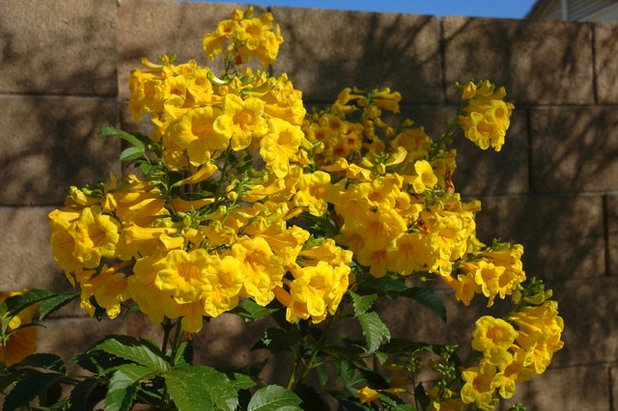
Noelle Johnson Landscape Consulting
Botanical names: Tecoma stans var.
stans and
Tecoma stans var.
angustataCommon names: Yellow bells, esperanza
Origin: Tecoma stans var.
stans is native to Mexico;
Tecoma stans var.
angustata is native to the southwestern United States
Where it will grow: Hardy to 20 degrees Fahrenheit (USDA zone 8; find your zone)
Water requirement: Low
Light requirement: Full, reflected sun to light shade
Mature size: 8 to 10 feet tall and wide
Benefits and tolerances: Drought tolerant once established, but does best when watered deeply once a week in summer, every two weeks in spring and fall and once a month in winter; attracts hummingbirds.
Seasonal interest: Golden flowers appear spring through fall in zones 8 to 11; if grown as an annual, it will flower throughout the summer into early fall until freezing temperatures arrive.
When to plant: In spring, from transplants
Shown: Flowering clusters of
Tecoma stans var.
stans
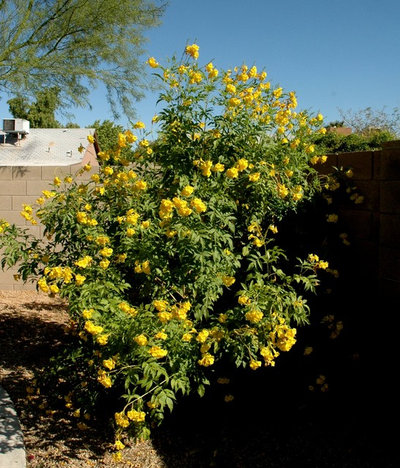
Noelle Johnson Landscape Consulting
Distinguishing traits. Wherever yellow bells shrubs are placed, hummingbirds will soon follow. Yellow bells can thrive in both desert and tropical gardens, providing a long season of beautiful yellow flowers.
The bright green foliage is made up of several narrow leaflets that bear clusters of yellow, bell-shaped flowers.
Although drought tolerant, yellow bells does require supplemental water — particularly in summer, when a weekly deep watering to a depth of 2 feet is appreciated. In spring and fall, watering every 2 weeks is usually sufficient.
Freezing weather will cause frost damage and can kill yellow bells back to the ground. However, it will quickly recover once temperatures begin to warm in spring. In zones 7 and colder, yellow bells can be grown as an annual.
Shown: Tecoma stans var
. stans screening a bare wall
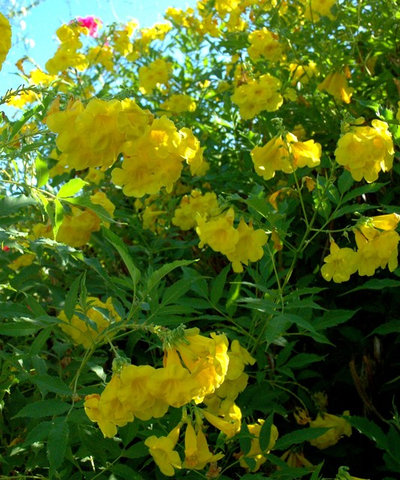
Noelle Johnson Landscape Consulting
There are two main varieties of yellow bells —
angustata and
stans, which look very similar. The uses and requirements are the same for both.
Because both types of yellow bells share a common name, it is important to refer to the botanical name in order to differentiate between the two when purchasing from your local nursery.
Shown: Flowering
Tecoma stans var.
angustata
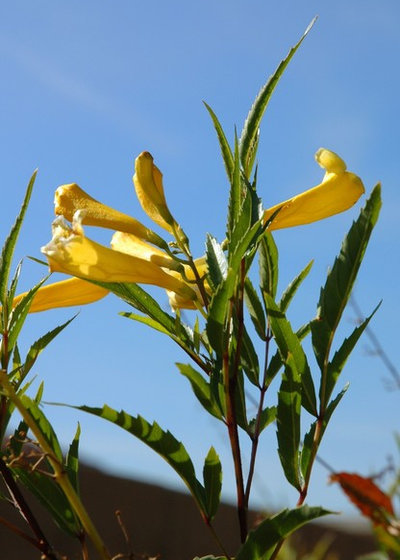
Noelle Johnson Landscape Consulting
While at first glance, it may be hard to tell the two varieties apart, there are some differences.
Let’s begin with
Tecoma stans var.
angustata, which is native to the southwestern United States. The leaves of this variety are narrower, and its flowers are slightly smaller than those of its Mexican cousin. This variety of yellow bells is cold hardier. While both varieties of yellow bells have seedpods, the variety
angustata produces a larger amount, which some find unattractive. However, they are easily pruned off.
Shown: Tecoma stans var. angustata
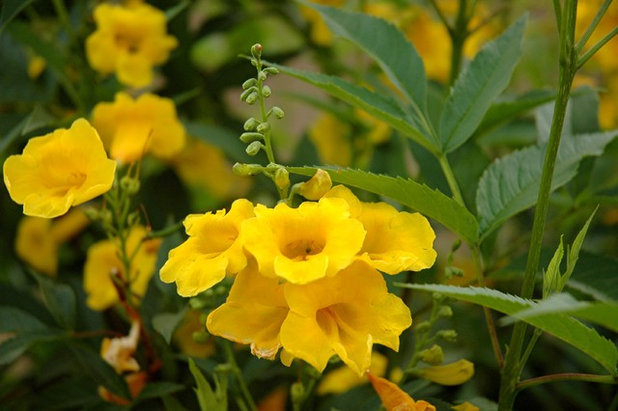
Noelle Johnson Landscape Consulting
Tecoma stans var.
stans is native to Mexico and has a slightly more tropical appearance than its Southwestern cousin, with its larger leaves and flowers. It is also slightly less cold hardy and produces fewer seedpods
.Shown: Tecoma stans var.
stans
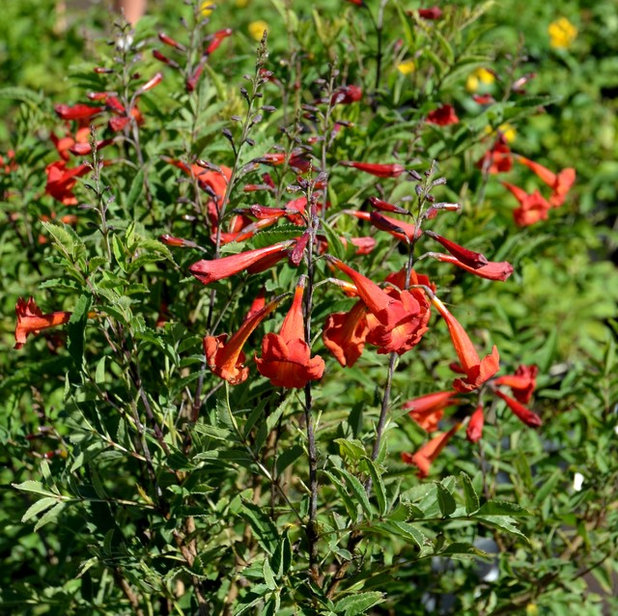
Noelle Johnson Landscape Consulting
In addition to the two main varieties, there are newer varieties of yellow bells available, some with different-colored flowers. Here are just a few:
- Tecoma ‘AZ Diablo’: Reddish-orange flowers
- Crimson Flare Esperanza: Red flowers
- Tecoma stans ‘Gold Star’: Yellow flowers; early bloomer; smaller size
- Solar Flare Esperanza: Orange flowers
- Sunrise Esperanza - Copper/yellow flowers
Shown: Tecoma ‘AZ Diablo’
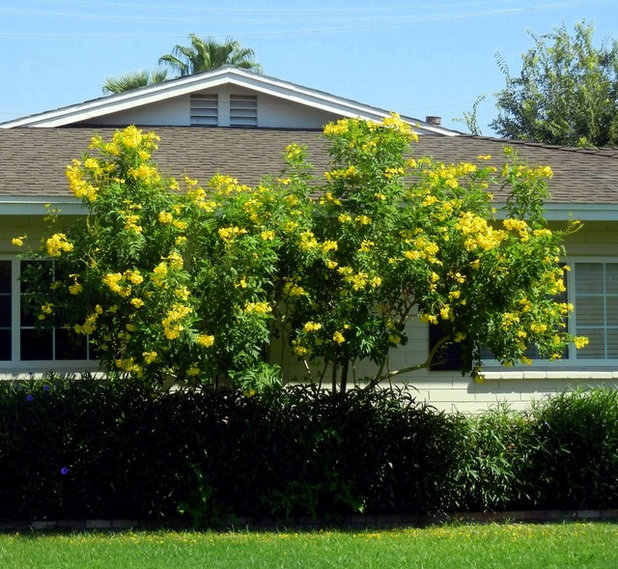
Noelle Johnson Landscape Consulting
How to use it. The large size of yellow bells makes it suitable to break up the expanse of a bare wall or fence. It can also be a great screen for an undesirable view; use it to hide an A/C unit or a utility area, for example.
In frost-free climates, yellow bells can be trained into a multitrunk tree form. It does well in large containers and looks great flanking an entry. Add purple-flowering
petunias around it in a container for great color contrast.
Need a hedge? Look no further. These large shrubs make a great, naturally shaped hedge for the side of a property. Plant purple-blooming plants in front, such as
‘Katie’ ruellia (
Ruellia brittoniana ‘Katie’) or
purple trailing lantana (
Lantana montevidensis).
Shown: Yellow bells grown as a tree
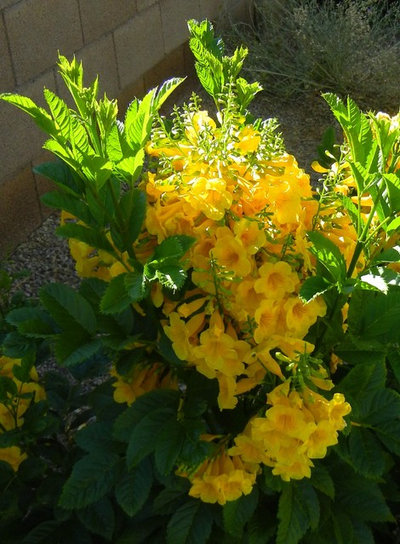
Noelle Johnson Landscape Consulting
Planting notes. Yellow bells needs well-drained soil. Dig the hole three times as wide and the same depth as the rootball, which will allow the plant to establish more quickly.
Planting this yellow beauty in areas with full sun is best, but it will grow in filtered shade, although the flowering will be reduced. For best results, apply a slow-release or organic fertilizer in the spring. Do not fertilize in the fall, which can stimulate frost-tender growth.
Shown: Tecoma stans var
. stans

Noelle Johnson Landscape Consulting
In spring prune any frost-damaged growth once the danger of frost has passed. In zone 8 that means pruning back to the ground. Rest assured that this beauty will grow back quickly.
Allow enough room for yellow bells to grow in order to minimize the need for pruning during the warm season. The seedpods, particularly on the variety
angustata, can be removed by hand pruners if desired, but this is not necessary for the health of the shrub.
Shown: Yellow bells after pruning frost-damaged growth in spring
Browse more bright and colorful flowers





